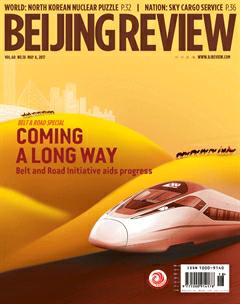Think Globally,Act Locally
Four years since the Silk Road Economic Belt and 21st-Century Maritime Silk Road Initiative, also known as the Belt and Road Initiative, was put forward, various regions in China have leveraged their advantages to support its implementation. As its initiator, China has exemplifi ed how this vision will be turned into reality.
Northwest China was on the ancient Silk Road routes. The region is a key area of the Silk Road Economic Belt, as it is a hub of transportation, logistics and trade as well as a center for industrial and cultural exchanges with Central, South and West Asia. Xinjiangs geographical location makes it an important window for opening up to the west. Provincial capitals Xian and Lanzhou, of Shaanxi and Gansu respectively, are centers of higher education and technology in west China. All these areas are committed to implementing the Belt and Road Initiative and seizing opportunities to boost local development.
Coastal areas are the key areas for the 21st-Century Maritime Silk Road. China has dedicated itself to developing the Pearl River Delta, the Yangtze River Delta, the Western Taiwan Straits Economic Zone and the Bohai Sea Rim Economic Region. More specifi cally, these areas have improved their competitive edge globally by embracing greater openness and beefing up technological innovation.
In the southwest, Guangxi Zhuang Autonomous Region has accelerated the opening up of the Beibu Gulf Economic Zone. Yunnan Province has stepped up construction of transportation links connecting to neighboring countries and pushed forward the Greater Mekong Subregion Economic Cooperation Program, becoming a bridge connecting China with South and Southeast Asia. Tibet has fostered cross-border trade and tourist and cultural cooperation with countries such as Nepal. Southwest China is turning into an international corridor facing ASEAN countries.
Northeast China focuses on improving railway links with Russia and facilitating landsea transportation with the Russian Far East. It is moving ahead with the Beijing-Moscow high-speed transport corridor and building itself into a platform opening up to the north.
Inland areas are cashing in on the initiative by joining the China-Europe freight train program, building international inland ports, carrying out cross-border e-commerce and engaging in industrial cooperation with the countries involved.
The Belt and Road Initiative aims to align Chinas development with globalization. The convening of the Belt and Road Forum for International Cooperation, the highest-level international conference to be hosted by China on the initiative, in Beijing from May 14 to 15 is a testament to the countrys eagerness to put more efforts into it. As the initiative delivers benefi ts for other countries along the routes, their participation will inject vitality into its unfolding.

